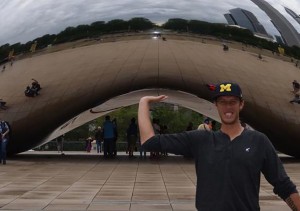Holdzkom’s Path To The Big Leagues Had Many Twists
If you work in or around independent ball for long, you better love the game. The pay isn’t great. The hours are long. And the rewards are somewhat ephemeral.
Yes, the champagne stinging your eyes in a post-championship locker room shower tastes just as sweet as in affiliated ball. And the bus rides are no more comfortable if you’re playing for a Braves’ Class A club than they are with an unaffiliated team in Amarillo.
But in indy ball you know that the next call isn’t going to be a major league general manager telling you you’re being promoted to the a big league job. More often as a manager or coach, you’re sweating whether you’ll win enough this year to have the same job next year.
It’s the little joys that make the hours worth it. It’s watching a catcher figure it out over the course of a year and go from a project who wears the gear to a leader who takes charge. And it’s the camaraderie of working with and helping players and other coaches and managers.
And every now and then, there’s the joy of a surprise success story that make all the frustrations worth it.
Over the past week, text messages have been bouncing around the indy ball universe. Mini-celebrations from guys in Wichita, Amarillo, San Angelo and Evansville.
When a player makes the big leagues from indy ball, all of indy ball celebrates. But the ones who played some small part in helping John Holdzkom fulfill his dream feel an adrenaline rush for days. The celebration lasts for weeks. They’ll be telling stories about it for years.
“You didn’t strike out three straight in Sioux Falls,” read Pirates scout Mal Fichman’s text to John Holdzkom after his three-up-three-down, three-strikeout big league debut at St. Louis on Tuesday night.
Holdzkom’s journey this year started with a less celebratory text.
“I know you probably don’t have a roster spot. But I’ve been released so I wanted to check and see,” read Holdzkom’s text to Amarillo manager Bobby Brown, just four months before he made his big league debut.
Holdzkom had failed to make the Sioux Falls roster out of spring training because his long-running wildness was too much for the club to take, even if he did throw 95-98 mph.
Brown didn’t have a roster spot. But he thought he knew where he could find one. In a similar situation a year before, Wichita manager Kevin Hooper had called him looking to find a spot for Holdzkom when he was getting ready to release him because of a roster crunch.
Brown found a YouTube video of Holdzkom pitching for New Zealand in the World Baseball Classic. The broadcasters were speaking Chinese, but Brown saw enough to take Holdzkom sight unseen.
So Brown got back to Holdzkom with the best option he could give him: take a job pitching at one of the lowest levels of independent baseball for $600 a month or give up and head home. Holdzkom took the job. A little more than three months later, he was pitching in the big leagues.
In just a few months, Holdzkom has gone from unwanted to needed. His resume had always been spotty: throws extremely hard, has no idea where it’s going and has a history of makeup issues. Before the Pirates signed him, he had been part of eight teams in the previous 13 months.
But he didn’t give up. And a long line of coaches and scouts didn’t either. Many, many times, Holdzkom could have detoured into a life of coulda-beens and what-might-bes.
He could have given up when he blew out his elbow in 2009. Or when the Mets released him in 2011. Or when the Reds let him go after a very brief stint with their high Class A club in 2012.
But all along the way, there were a series of managers, scouts and coaches who always tried to get him another chance.
In 2013, it was Hooper calling around to find him another job before cutting him loose. That same winter, his Australian Baseball League manager Charlie Aliano and pitching coach Mickey White could have kept him glued to the bullpen bench rather than watch him fight through control issues.
This spring Brown, his former manager in Amarillo, could have simply told him “sorry, my roster’s full” when Holdzkom reached out for a job. Instead, he called Edwards and found him a spot.
And once he’d worked his way back to Amarillo this spring, if Holdzkom had needed just a few more moments to get up and get loose in the bullpen, Fichman, scouting for the Pirates, would have never noticed him.
It’s a long-running series of extra calls, amazing coincidences or destined moments. Let’s start near the end.
Mal Functions
There are few people in baseball who have seen more independent league games than Fichman. Now a Pirates scout, Fichman has scouted indy ball for years, a niche that is occupied by him and very few others. Before that, he was one of the original indy ball managers back when the Northern League was founded in 1993. Before that, he scoured the country to sign his own players for an independent team in affiliated ball, a relic of an earlier time.
But as this Sioux Falls-Amarillo game ground on in mid-June, it was time to go. Fichman wasn’t in a great mood. Weather had scotched batting practice, costing him useful scouting time. He’d sat through seven innings, it was starting to rain and there were tornadoes popping up around the area. No player on either team was really standing out to him, and he’d be around for the next two games of the series. For a scout, it’s about knowing when to head home and get ready for another day.
So Fichman started to pack up. He grabbed his stopwatch from the cupholder, started to put away his papers and disassembled his Stalker radar gun.
But before he could finish packing he took a glance out to the Amarillo bullpen. He doesn’t really know why, because in Sioux Falls, you can’t see anything in the bullpens. The bullpens are nestled in corners behind the seats, so all you usually see is the top of a pitcher’s head as he warms up.
When he looked out there this time, he could see the word “Amarillo” on the pitcher’s jersey.
“You don’t see a lot of independent league players who are 6-foot-7 or 6-foot-8,” Fichman said.
The stopwatch went back in the cupholder. The papers came back out and Fichman turned his radar gun back on.
In came John Holdzkom. The first pitch registered 94 on Fichman’s gun. He thought that maybe the battery in his radar gun was wearing out. He swapped batteries to a fresh one. The next pitch was 95. He soon saw a 96. Quickly, the inning was over, as Holdzkom pitched a perfect eighth. Three outs later, the game was over.
This time Fichman didn’t pack up. The stopwatch stayed in the cupholder, the detritus of a night of scouting surrounding his seat. He grabbed his papers and rushed down to the dugout to talk to this surprising find.
“I was looking up at him. He was looking down at me,” Fichman said. “I asked ‘Do you normally throw like that?’ “
“He told me ‘no.’ Oh, OK. So this was unusual? ‘Well, yeah,’ he said, ‘I was throwing my two-seamer tonight. When I throw my four-seamer, I can get it up to 97-98 mph.’ “
Fichman handed Holdzkom an information sheet. It’s something he’s handed to countless players over the years. On the front is the standard stuff. Name, date of birth, height, weight. But flip the page over and there’s a spot for “additional information.”
Usually a player will list his best tool. A lot of indy ball pitchers will write about their best fastball velocity, often with an extra mile per hour or two added for some useful exaggeration.
Holdzkom wrote an apology of sorts. He wrote that he realized over the past few years how he needed to mature. He’d realized all the things he’d done wrong in the game and how he wanted to do better.
Running Into Trouble
Those few sentences said a lot about where Holdzkom is now compared to where he once was. There was a time when Holdzkom was known as much for his on and off-field mistakes as his 97-98 mph fastball. Holdzkom has always thrown hard, but scouts often had trouble getting to see him use it.
As a high school senior, Holdzkom was academically ineligible for part of the season, then missed most of the rest of it because of run-ins with his coach.
Holdzkom didn’t pitch much more in his one year at Salt Lake Community College because he quit the team after an argument with his coach during a game.
The Mets loved his arm and signed him anyway, giving him $210,000 as a fourth-round pick. His volatile ways followed him to pro ball. Eventually the Mets tired of lack of control on and off the field. He walked 10 batters in five innings in his last stint with the Mets in 2010.
Holdzkom’s itinerant travels didn’t help his confidence, either. Amarillo’s Brown remembers one of this first conversations with the big righthander. He was explaining how the Sox reimburse for travel expenses. Holdzkom would buy his ticket to fly in, and the Sox would then cut him a check to pay him back for the trip when he joined the club. Holdzkom then asked Brown if the club would also pay his travel expenses to get home if they cut him.
“John, the answer to the question is yes, but if you ask that question, I don’t know if I want to sign you,’ ” Brown remembers telling Holdzkom. “I wasn’t bringing him in to cut him. I had to pump him up to be confident in himself.”
Coach after coach remembers thinking much of the same thing. Holdzkom stands 6-foot-7. He throws as hard as almost anyone in baseball. But for the longest time, he carried himself almost sheepishly. Adelaide pitching coach Mickey White’s focus during Holdzkom’s time in Australia was as much about teaching him to believe in himself as it was to fix any mechanical problem on the mound.
It’s understandable that Holdzkom didn’t bring much swagger to the mound. When you’ve been called into office after office to be told you aren’t needed any more, it leaves a mark.
But in many ways it was his last release this spring that set up his path to the big leagues.
When Brown called Doc about Holdzkom, he told him what he was getting: one of the best arms in indy ball, but one whose wildness could drive a manager crazy. He’d once seen Holdzkom get 0-2 on a batter in an extra-inning game, then throw back-to-back pitches over the catcher’s head that allowed the winning run to score.
“He had 2-to-3 feet of natural cut on his fastball and he didn’t know where it was going,” Brown said.
A few days later, an opposing batter told Brown what he’d figured out. He’d never be able to hit Holdzkom’s cutting 97 mph fastball, but if he never swung he was pretty confident Holdzkom would never throw three pitches over the plate.
“When that report gets out and you’re playing Grand Prairie and Laredo eight times each down stretch, you can’t use him,” Brown said.
In the Australian League that winter, Aliano and White, both long-time scouts, were also big believers in Holdzkom. He had the best arm in the league. In his first outing, Holdzkom threw 4 2/3 hitless innings. The only problem? He walked seven and hit another batter to give up three runs.
“No one could hit him, but he couldn’t throw strikes,” Aliano said.
Throughout his indy ball travels, catchers generally set up with their mitt in the middle of the plate for Holdzkom. If he aimed for the middle of the plate, they hoped he might catch a corner for a strike.
So Holdzkom arrived in San Angelo this spring with a $600 a month paycheck and a hope that he might work his way back to Amarillo if he threw enough strikes. Not long after he got there, San Angelo pitching coach Demetrius Banks was watching him throw a bullpen.
“Do you always spread your fingers like that when you throw your fastball?” Banks asked. Holdzkom told him he did. “How about trying to throw a fastball with your fingers closer together?” Banks suggested.
The next few pitches were in the strike zone.
“With his fingers spread, sometimes it would roll off his index finger and it would cut,” Banks said. “When it rolled off of his middle finger it would be a two-seamer.”
Holdzkom had pitched for countless teams over the years. No one had ever figured out how to get him to throw strikes. In one side session, Banks had unlocked the secret.
“I give credit to J.R. Perdew, my old pitching coach when I played,” said Banks, a former White Sox farmhand. “He told me, ‘Make it as simple as possible. You don’t have to put too much into it. Keep it simple. It’s not rocket science.’ I hope that helped John. He did all the work, but I hope it helped.”
From 2006-13, Holdzkom had walked at least 5.5 batters per nine innings every year. He’d walked 143 batters in 177 innings as a pro. With the new grip, he’s walked 14 in 37 2/3 innings (3.3 per nine innings).
In his first inning with San Angelo, Holdzkom struck out two and walked no one in a scoreless inning of work. Edwards’ phone rang. It was Brown. He needed pitching help, so could Doc please send John back to Amarillo?
When Holdzkom got back to Amarillo, he hadn’t overhauled his delivery or made any other massive tweak. But with his new fastball grip, he had control to hit spots like he’d never had before. In his first seven outings in Amarillo, he walked only two batters. No longer did a catcher have to set up in the middle of the plate; now they could get Holdzkom to throw to quadrants of the strike zone.

Holdzkom moved his fingers closer together on the advice of San Angelo pitching coach Demetrius Banks.
In his June 17 outing with Fichman watching and dodging the rain drops, Holdzkom walked no one. The next day, Fichman was at the ballpark at 1 p.m. waiting when the Sox arrived. He talked to Holdzkom. He talked to Holdzkom’s home and road roommates, who vouched for the big righthander’s newfound steadiness off the field. He talked to catcher Jeff Farnham, a former Yankees’ minor leaguer with Double-A time.
“I asked him ‘What do you think?’ He told me, ‘He’s a big league pitcher.’”
Lastly, Fichman talked to Brown and asked him to please throw Holdzkom in one of the final two games of the series so he could see him one more time. Brown gave Holdzkom that night off, but the next night he brought him back in to pitch the final inning of a loss as a favor for Fichman. The stuff was the same.
Fichman’s recommendation was for the Pirates to sign Holdzkom, but he had to get Tyrone Brooks, the club’s director of baseball operations, to sign off before he could make Holdzkom a Pirate.
As Fichman headed off to his next city to see his next team, Brooks and other front office members met to talk over Holdzkom. Four days after he first set eyes on Holdzkom, Fichman got the email back from Brooks telling him the good news: Send Holdzkom to Altoona for a physical and if it all goes well, he’s a Pirate.
Four days later, Holdzkom made his Altoona debut with two scoreless innings. He was in Triple-A less than two weeks later. Fichman remembers getting a email a few weeks later that with much of the Pirates’ front office in attendance, Holdzkom touched 101 mph.
The next message was even better.
“(Brooks) called me Sunday night. I was in Edmonton,” Fichman said. “He asked me, ‘Are you sitting down?’ Holdzkom is going to be put on 40-man roster today. He said he’s doing it so he’s eligible for the playoffs. He’ll join the club in St. Louis.”
Like any job, there are good guys and bad guys in baseball. But a whole lot of men who love the game formed a chain that helped Holdzkom get to the big leagues. When John’s brother Lincoln Holdzkom was looking for a job, a scout called Wichita’s Hooper to get them hooked up. That led Hooper to acquire John after hearing about him from Lincoln. When Hooper was going to release Holdzkom in 2013, he made the phone call to Brown. When Brown ended up trading Holdzkom, he kept in touch with his big righthander.
San Angelo’s Edwards was willing to sign him sight-unseen on Brown’s recommendation. That got him to a bullpen mound where Banks could work with him on a grip tweak. After he got back to Amarillo, Brown was willing to put him back on the mound in a game he didn’t need to pitch to try to help him get an affiliated job.
Holdzkom’s teammates universally vouched for him, eliminating the concerns that may have kept Fichman from recommending he be signed. And Brooks and the Pirates front office were willing to trust their scout that any sketchy makeup questions that Holdzkom had once faced were now in the past.
“What he wrote on the back of the info sheet was personal. He figured out what was going on,” Fichman said. “He’s grown up. He was very honest.”
On Monday, by chance, Fichman was driving through St. Louis on his way to the airport. He’d just taken in a game in Evansville, Ind., and was flying out to see another club on his season-long journey around the independent leagues.
Fichman crossed over the Mississippi River on Interstate 64. On his radio was playing the song, “You’ve Lost That Loving Feeling” and he was singing along. He looked to his right and saw Busch Stadium.
It was one of those rare perfect moments as a scout that validates the long road trips. Fichman knew that the next day, Holdzkom would be at Busch Stadium wearing a big league uniform.
What if Holdzkom had decided to treat a release as a reason to do something else? If Fichman had just kept walked out of the ballpark without taking a glance over to the bullpen? If one of Holdzkom teammates had warned Fichman to stay away because the rumors about Holdzkom’s makeup problems were true? If, if, if.
Fichman started laughing. In a car by himself with the music turned up, he just laughed at the joy of the moment and the incredible chain of events that had to come together to make this moment happen.
He laughed so hard, he missed his turn to the airport. And he didn’t care.




Comments are closed.